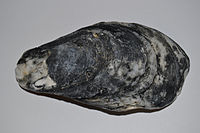
Photo from wikipedia
The Portuguese oyster Crassostrea angulata shows great potential in oyster farming. The conservation of pure populations of this species is important for production diversification and biodiversity preservation. In this way,… Click to show full abstract
The Portuguese oyster Crassostrea angulata shows great potential in oyster farming. The conservation of pure populations of this species is important for production diversification and biodiversity preservation. In this way, the zootechnological development for seed hatchery production is extremely important. Broodstock conditioning is a key step in the process of rearing bivalves in a hatchery. Many factors regulate the reproductive cycle, being food one of the most important ones. To evaluate the effect of different diets on C. angulata reproductive performance, broodstock were conditioned with different food regimes formulated fundamentally by flagellates (Diet 1 – Pavlova lutheri and Isochrysis galbana clone T-ISO; Diet 2 – P. lutheri, T-ISO and Skeletonema costatum) and constituted fundamentally by diatoms (Diet 3 – S. costatum and Chaetoceros calcitrans; Diet 4 – P. lutheri, S. costatum and C. calcitrans). During conditioning, samples of oysters were collected to evaluate condition index, gonadal development and biochemical composition. At the end of the conditioning period, oysters were induced to spawn to evaluate reproductive output (fecundity, fertilization rate and D-larvae development). The diets had an impact on the gametogenesis process, energy storage and reproductive output performance, being the best results those obtained in broodstock fed with the diatoms-predominant diets. However, those fed with diets majority flagellates had an unsuccessful performance. Holistic approaches incorporating all results in this study reveal and reinforce the idea that the diatom species used presented the nutritional requirements to C. angulata broodstock, being essential in the conditioning phase.
Journal Title: Aquaculture Research
Year Published: 2017
Link to full text (if available)
Share on Social Media: Sign Up to like & get
recommendations!